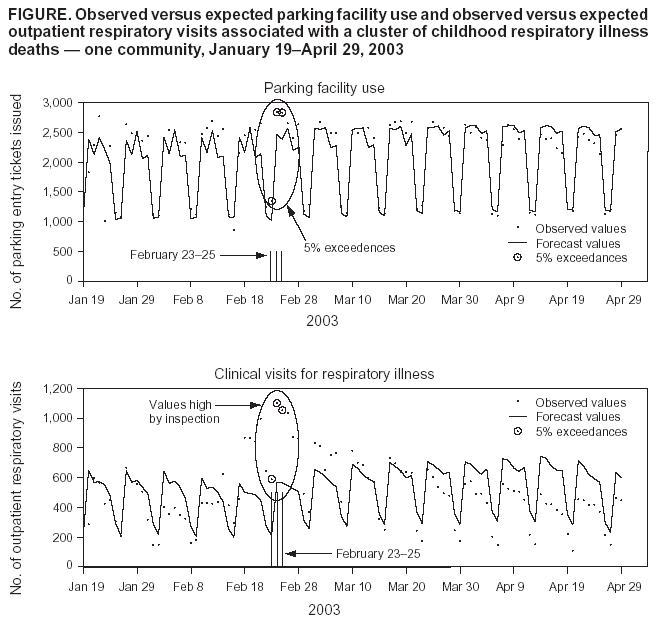 |
|
|
|
|
|
|
| ||||||||||
|
|
|
|
|
|
|
||||
| ||||||||||
|
|
|
|
|
Persons using assistive technology might not be able to fully access information in this file. For assistance, please send e-mail to: mmwrq@cdc.gov. Type 508 Accommodation and the title of the report in the subject line of e-mail. Temporal Correlation of Nontraditional and Traditional Evidence of a Natural OutbreakDouglas Stetson, R. Bloom, D. Crary, K. Cheng, G. McClellan
Corresponding author: Douglas Stetson, 1400 Key Blvd., Ste. 100, Arlington, VA 22209. Telephone: 757-377-5283; E-mail: douglas.stetson@gd-ais.com. AbstractIntroduction: Although syndromic surveillance typically involves monitoring of traditional clinical data sources (e.g., emergency department visits), monitoring nontraditional sources might also provide information about community health. This study demonstrated that parking use data from a medical center parking facility reflected an unusual increase in regional outpatient visits for respiratory illness associated with a well-publicized public health event. Objective: This study aimed to determine whether a nontraditional source (i.e., parking facility use data) reflected a sudden communitywide surge in health-care facility use associated with widespread news coverage of an unexpected local cluster of respiratory illness-related deaths among children. Methods: Two data sources were collected and compared for the period in which the cluster occurred: 1) daily parking facility use data from a parking structure serving a medical center complex and 2) regional counts of outpatient respiratory visits to military treatment facilities made by military members and their families. Daily localized forecasts of expected parking use and outpatient visits were generated on the basis of recent historic counts to reduce cyclic influences (e.g., day-of-week effects). Daily variations in parking and clinic volume and differences between actual volume and forecast volume were analyzed for statistical significance. Results: A statistically significant increase in actual parking facility use compared with expected use was identified, coincident with both the statistically significant increase in actual outpatient respiratory visits compared with forecast visits and with the period of local news reporting on the cluster of deaths (February 23--25, 2003) (Figure). No other variations in the parking or outpatient-visit data during that calendar quarter had similar statistical significance. Conclusion: Syndromic surveillance efforts can be supported by standard analytic and statistical examination of nonclinical, real-world data. Figure Return to top.
Disclaimer All MMWR HTML versions of articles are electronic conversions from ASCII text into HTML. This conversion may have resulted in character translation or format errors in the HTML version. Users should not rely on this HTML document, but are referred to the electronic PDF version and/or the original MMWR paper copy for the official text, figures, and tables. An original paper copy of this issue can be obtained from the Superintendent of Documents, U.S. Government Printing Office (GPO), Washington, DC 20402-9371; telephone: (202) 512-1800. Contact GPO for current prices. **Questions or messages regarding errors in formatting should be addressed to mmwrq@cdc.gov.Page converted: 9/14/2004 |
|||||||||
This page last reviewed 9/14/2004
|